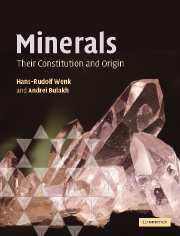Book contents
- Frontmatter
- Contents
- Preface
- Acknowledgments
- Figure credits
- Part I Structural features of minerals
- Part II Physical investigation of minerals
- Part III Variety of minerals and mineral-forming processes
- Part IV A systematic look at mineral groups
- 19 Important information about silica materials and feldspars
- 20 Simple compounds. Unusual mineral occurrences
- 21 Halides. Evaporite deposits
- 22 Carbonates and other minerals with triangular anion groups. Sedimentary origins
- 23 Phosphates, sulfates, and related minerals. Apatite as a biogenic mineral
- 24 Sulfides and related minerals. Hydrothermal processes
- 25 Oxides and hydroxides. Review of ionic crystals
- 26 Orthosilicates and ring silicates. Metamorphic mineral assemblages
- 27 Sheet silicates. Weathering of silicate rocks
- 28 Chain silicates. Discussion of some igneous and metamorphic processes
- 29 Framework silicates. Zeolites and ion exchange properties of minerals
- Part V Applied mineralogy
- Appendices
- Glossary
- References
- Index
- Plate section
- References
28 - Chain silicates. Discussion of some igneous and metamorphic processes
from Part IV - A systematic look at mineral groups
- Frontmatter
- Contents
- Preface
- Acknowledgments
- Figure credits
- Part I Structural features of minerals
- Part II Physical investigation of minerals
- Part III Variety of minerals and mineral-forming processes
- Part IV A systematic look at mineral groups
- 19 Important information about silica materials and feldspars
- 20 Simple compounds. Unusual mineral occurrences
- 21 Halides. Evaporite deposits
- 22 Carbonates and other minerals with triangular anion groups. Sedimentary origins
- 23 Phosphates, sulfates, and related minerals. Apatite as a biogenic mineral
- 24 Sulfides and related minerals. Hydrothermal processes
- 25 Oxides and hydroxides. Review of ionic crystals
- 26 Orthosilicates and ring silicates. Metamorphic mineral assemblages
- 27 Sheet silicates. Weathering of silicate rocks
- 28 Chain silicates. Discussion of some igneous and metamorphic processes
- 29 Framework silicates. Zeolites and ion exchange properties of minerals
- Part V Applied mineralogy
- Appendices
- Glossary
- References
- Index
- Plate section
- References
Summary
Structural and chemical features
In Chapter 27 we discussed the structures of sheet silicates with infinite two-dimensional layers of hexagonal tetrahedral nets. We noted that there are some deviations from infinite nets in the structures of paligorskite and sepiolite, where, instead of infinite sheets, finite strips are stacked in a brickwork fashion (see Figure 27.9). In chain silicates such strips are much narrower and extend only over one or two tetrahedra. From an infinite tetrahedral sheet, say of talc (Figure 28.1a), we can obtain simple strips in various ways. Figure 28.1b–d illustrates some of the possibilities for which there are mineral representatives. In Figure 28.1b a band consisting of four tetrahedra is cut from the sheet in the vertical direction. By doing so we obtain a double chain, which is present in amphibole minerals. In Figure 28.1c a narrow band of two tetrahedra forms a single chain, representative of pyroxenes. Finally, in Figure 28.1d a strip of three tetrahedra is cut from the sheet in the horizontal direction, at right angles to pyroxenes and amphiboles. Also this scheme is observed in nature in the rare iron-rich mineral howieite (NaMg10Fe3+2Si12O34(OH)10).
As in sheet silicates, tetrahedra in chain silicates are attached on both sides of octahedral units. This is illustrated for pyroxenes in Figure 28.2a, b and for amphiboles in Figure 28.2c, d. The chain units run along the c-axis of crystals and are parallel to (100). When viewed along c, the units are regularly stacked (Figure 28.2c,d).
- Type
- Chapter
- Information
- MineralsTheir Constitution and Origin, pp. 470 - 495Publisher: Cambridge University PressPrint publication year: 2004



